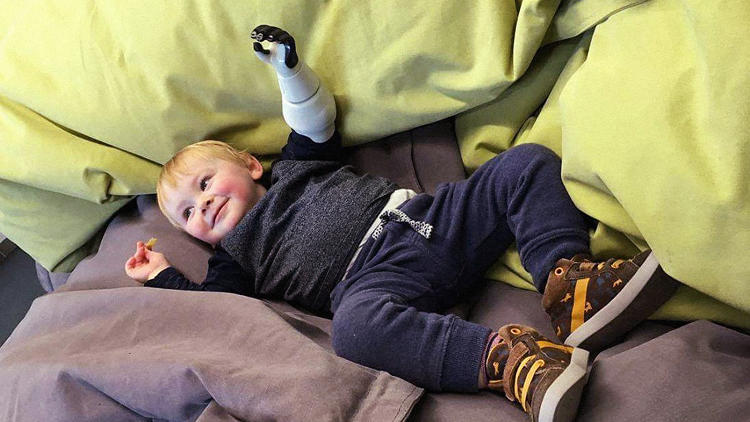A father revolutionized the world of prosthetics after his son was forced to have an arm amputated 10 days after he was born.
Ben Ryan’s son, Sol, was injured during his delivery and developed a blood clot in his arm that led to amputation. His parents were devastated when they learned their baby wouldn’t be eligible for a prosthetic until he was 1 year old and probably wouldn’t be able to hold anything until he was 3.
“I knew that doing nothing for a whole year was never an option,” Ryan told Care.com. “I started making foam arms to help Sol reach his toys as soon as he got back from the hospital. It just went from there, really.”
It wasn’t that medical officials didn’t want to help Sol, but technology hasn’t yet solved this issue for babies and toddlers.
“When Sol was 3 months old, we were told that bionic hands weren’t suitable until 3 or 4 years of age,” Ryan said. “This is because of the fat babies have which can stop signals being read and the dangers of exposing electrical systems to water and the fact that the motors can be powerful.”
Bionic limbs are electronic prosthetics that pick up on nerve signals through the skin to control electric motors. Ryan, who has no background in prosthetics or engineering, became obsessed with finding a solution for his child and other kids like him.
“I looked at what was out there and tried to think of a better way,” he said. “One night, I saw a spider on the ceiling, and it reminded me about how they straighten their legs by pumping them full of fluid. Their legs are hollow. The idea was like an infection. I went to work right away building hydraulic systems out of off-the-shelf parts.”
What the dad created is a prosthetic that is custom-designed for each kid and can be 3D-printed in three days.
“Once I realized it would work, I taught myself how to use design software, and my local university taught me how to use 3D printers,” he said.

Building off his success with his son’s device, Ryan decided to focus on the project full-time and launched a startup called Ambionics.
“We have created a new market,” Ryan said. “Quite literally, nothing like this has been done before.”
The way Ryan sees it, there’s no point in waiting to help children learn how to function with their prosthetics. He said he can produce functional arms in only a few days, and he can replace missing parts from their original files.
“There’s lots of evidence to show that my intervention program should improve the number of children who adopt prosthetics,” Ryan said. “Think about it this way: If children were not introduced to shoes until 3 or 4 years of age, then they wouldn’t wear them.”
He said, ultimately, shoes and prosthetics are just wearable technology, and adapting to technology at a young age is crucial.
“The brain goes through a rapid period of ‘nerve pruning’ in the first two and a half years of life,” he said. “We each start off with about twice the nerves we ever need, and the ones which are not used often are cut away. If wearing and using prosthetics is not mastered before that period of pruning ends, then children will never fully engage with prosthetics as well as they could.”
Price is also a key issue for Ryan, as he says he wants to make sure underprivileged kids have access to prosthetics, as well.
“I intend to help children everywhere,” he said. “I’m in discussions with The Leprosy Mission and similar organizations that have already identified cases where existing technology will not work but where body powered hydraulics is a good match.”
Ryan launched a crowd funding campaign to help raise funds needed to finish the patent and prototyping, as well as to secure FDA approval.
“I want to help as many children as I can,” he said.






